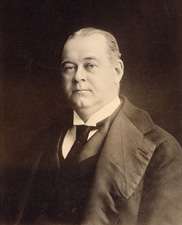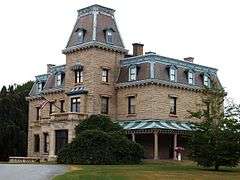George P. Wetmore
| George Peabody Wetmore | |
|---|---|
 | |
| United States Senator from Rhode Island | |
|
In office March 4, 1895 – March 3, 1907 | |
| Preceded by | Nathan F. Dixon III |
| Succeeded by | Vacant, failure to elect |
|
In office January 22, 1908 – March 3, 1913 | |
| Preceded by | Vacant, failure to elect |
| Succeeded by | Lebaron B. Colt |
| 37th Governor of Rhode Island | |
|
In office May 26, 1885 – May 29, 1887 | |
| Lieutenant | Lucius B. Darling |
| Preceded by | Augustus O. Bourn |
| Succeeded by | John W. Davis |
| Personal details | |
| Born |
August 2, 1846 London England |
| Died |
September 11, 1921 (aged 75) Boston, Massachusetts |
| Political party | Republican |
George Peabody Wetmore (August 2, 1846 – September 11, 1921) was the 37th Governor of and a United States Senator from Rhode Island.
Early life
George Peabody Wetmore was born in London, England, during a visit of his parents abroad. His father was William Shepard Wetmore, a wealthy Yankee trader. George Wetmore received his early education at the private schools of Messrs. Reed and Thurston and of the Rev. William C. Leverett in Newport, Rhode Island. In 1867 he graduated from Yale College, where he was a member of Skull and Bones.[1]:104 After graduation he studied for two years at the Columbia Law School. He received the degree of LL.B. in 1869, and was admitted to the bars of Rhode Island and New York the same year, although he never practiced.[2]
Politics
He had always taken an active interest in politics and in 1880 and 1884 was a presidential elector. He was elected Governor of Rhode Island in 1885 and served two terms, but was defeated for a third term. He was a member of the commission that built the new Rhode Island State House at Providence.[2]
In 1894 he was elected as a Republican to the United States Senate, receiving the unanimous vote of the General Assembly in Senate, House, and joint convention. He was re-elected in 1900 and served from March 4, 1895 to March 3, 1907.
In 1907, he was challenged for his seat by another Republican, industrialist Samuel P. Colt. The three-way contest between Wetmore, Colt and Democrat Robert Hale Ives Goddard resulted in months of deadlocked ballots and a vacant seat in Rhode Island's delegation to the 60th Congress beginning on March 4, 1907. Eventually Colt withdrew, and Wetmore returned to the Senate on January 22, 1908 and served until March 3, 1913. Colt's brother, LeBaron B. Colt, was elected to succeed Wetmore upon Wetmore's retirement from the Senate.[2]
In the Senate, Wetmore was, first, chairman of the Committee on Manufactures, and then chairman of the Joint Committee on the Library for sixteen years. He was also a member of the Appropriations, District of Columbia, Naval Affairs, Public Buildings and Grounds, and other committees. His last term in the Senate ended March 4, 1913.[3]
He had a deep interest in the building up of the Navy and the development of the naval base in Narragansett Bay. He served as chairman of the joint commission appointed by Congress to prepare plans for the completion of the United States Capitol in Washington; was chairman of the first Lincoln Memorial Commission and a member of the commission that erected the National Lincoln Memorial in Washington; and was a member of the Grant Memorial Commission, as well as many others for the erection of statues and memorials. He was greatly interested in the improvement and development of Washington and the District of Columbia on a definite artistic plan, and was particularly identified with the legislation creating the National Commission of Fine Arts.[3]
Cultural work

In private life Mr. Wetmore was for many years associated with various organizations for promoting the fine arts. He was one of the organizers of the Metropolitan Opera in New York and a member of the committee in charge of the construction of the Metropolitan Opera House. He was a trustee of the Peabody Museum of Natural History at Yale and of the Peabody Education Fund. In 1888 he was nominated as a Fellow of the University, but declined to have his name considered. He was one of the founders of the Jockey Club, vice president of the National Horse Show Association of America, and a director of other organizations for improving the breeding of horses.[3]
At his home in Newport he was a trustee of the Redwood Library and Athenaeum, president and a trustee of the Newport Hospital, and president of the Newport Reading Room and the Newport Casino. In 1877 he was admitted as a member of the Massachusetts Society of the Cincinnati.[3]
Family and legacy

He was married December 22, 1869, in New York City, to Edith Malvina Keteltas. Her father, Eugene Keteltas, had been a member of the Yale College Class of 1822, but left before graduation, and was graduated at Union College in 1822. Yale gave him the honorary degree of M.A. in 1870. Mrs. Wetmore's grandfather, Philip Doddridge Keteltas, was Yale 1792; her great-grandfather, Rev. Abraham Keteltas, graduated at Yale in 1752 and was admitted to the M.A. degree at Yale and Princeton University in 1755; and her great-great-grandfather, William Smith, was Yale 1719.[4]
Edith Keteltas Wetmore's brother was Brevet Lieutenant Colonel Henry Keteltas who served in the American Civil War as a captain in the 15th United States Infantry. He received two brevets (honorary promotions) for gallantry in action. His sword is preserved and on display at the Chateau Sur Mer mansion.
Mr. and Mrs. Wetmore had four children: Edith Malvina Keteltas; Maude Alice Keteltas; William Shepard Keteltas (B.A. 1897); and Rogers Pickman Derby Keteltas.[3]
Mr. Wetmore died September 11, 1921, in Boston. His funeral was held at Trinity Church in Newport, and he was buried in Newport's Island Cemetery.[3]
George Wetmore's estate in Newport Rhode Island, Chateau-sur-Mer, is today owned by the Preservation Society of Newport County and is open for tours during the summer. It is considered one of the best surviving examples of a Victorian mansion.
Wetmore was also a litigant in the Supreme Court of the United States decision: George Peabody Wetmore v. Tennessee Copper Company, 218 US 369 (1910).[5]
References
- ↑ The twelfth general catalogue of the Psi Upsilon Fraternity. 1917. Retrieved March 24, 2011.
- 1 2 3 Official Congressional Biography and Resources (accessed Jan. 1, 2009)
- 1 2 3 4 5 6 "George P. Wetmore, Ex-Senator, Dies" New York Times, Sept. 12, 1921 (accessed Jan. 1, 2009) http://query.nytimes.com/gst/abstract.html?res=9D00E1DE153EEE3ABC4A52DFBF66838A639EDE
- ↑ Prominent Families of New York (BiblioBazaar, LLC, 2009) pg. 617 https://books.google.com/books?id=wUDrgpf4hwMC&source=gbs_navlinks_s
- ↑ George Peabody Wetmore v. Tennessee Copper Company, 218 US 369 (1910)http://supreme.justia.com/us/218/369/case.html
| Wikimedia Commons has media related to George P. Wetmore. |
External links
- Wetmore Collections at the Rhode Island Historical Society
- Official Congressional Biography and Resources
- Chateau Sur Mer Official Website
| Political offices | ||
|---|---|---|
| Preceded by Augustus O. Bourn |
Governor of Rhode Island 1885–1887 |
Succeeded by John W. Davis |
| United States Senate | ||
| Preceded by Nathan F. Dixon, III |
U.S. Senator (Class 2) from Rhode Island March 4, 1895 – March 3, 1907 January 22, 1908 – March 3, 1913 |
Succeeded by LeBaron B. Colt |

